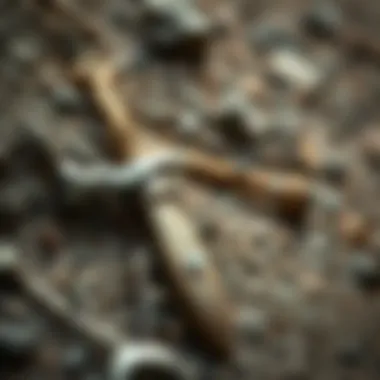Discover Local Gem Mines: A Guide to Hidden Treasures


Intro
Gem mining has a way of drawing enthusiasts into its colorful tapestry of wonder, history, and geology. As the earth hides a treasure trove of sparkly gems, many people yearn to uncover these dazzling gifts, from quartz to rare pink tourmaline. For those operators in the craft, or even curious explorers, local gem mines offer not just an opportunity to dig in, but also a unique glimpse into the planet’s geological story.
As this guide unfolds, it’ll take you through the ins and outs of gem mines, shedding light on the types of gems often discovered, how to identify what you’ve stumbled upon, and the historical aspects that make these ventures fascinating. Expect to find some gems of wisdom along the way, crafted specifically to enhance both the novice and seasoned collector’s experience.
Get ready to embrace the natural world as we set the scene for a whirlwind journey through gem mines, perfect for anyone looking to dig a little deeper into the art and science of gem collecting.
Prelims to Gem Mining
Mining for gemstones is not just a quest for shiny trinkets; it offers a gateway into the rich tapestry of Earth's geological history and natural beauty. This article explores the allure of gem mining, outlining the myriad layers it brings to both casual enthusiasts and hardened collectors alike. Participating in gem mining can ignite a passion, drive communities, and conjure a profound appreciation for the Earth's inner treasures.
What is Gem Mining?
Gem mining is the process of extracting precious and semi-precious stones from the Earth. This involves sifting through rock, soil, and gravel, which can be as simple as panning in a river or as complex as digging deep into the ground. The notion is straightforward, but the undertaking can be an art in itself.
You see, it takes more than just a pickaxe to find those elusive gems. Knowledge about geology, the nuances of different formations, and understanding where specific stones are likely to hide can be a game-changer. For instance, sapphire deposits often sit in riverbeds where the rocks erode and crumble into smaller fragments. If you know where to look, the hunt can be as rewarding as the find. Additionally, gem mining can offer valuable experiences; it's an opportunity for people of all ages to connect with the earth, share compelling stories, and appreciate the labor behind these natural wonders.
Historical Context of Gem Mining
The history of gem mining traces back thousands of years, intertwining with human culture and civilization. Ancient civilizations, such as those in Mesopotamia and India, revered gemstones not merely for their beauty but also for their perceived powers and symbolism. For example, consider the sapphire: in medieval times, it was believed to protect its wearer from envy and harm.
Moreover, gem mining has significantly impacted economies and societies. The Gold Rush, not solely about gold, found many miners dishing through ore for gems like quartz and garnet. This movement fostered community ties, transformed landscapes, and ignited exploration in regions previously untouched by settlers. Even today, areas rich in gem deposits can become hotbeds for tourism and local business, contributing to the economy and heritage.
The layers of history and culture behind gem mining create a realm far beyond gilded stones. It fosters a connection between generations, binding people to their roots and to the Earth in ways that materials alone cannot express. As this guide unfolds, we will explore the treasures waiting to be discovered and the vital knowledge necessary to thrive in this engaging pursuit.
Finding Gem Mines Near You
Finding local gem mines is crucial for anyone who has a penchant for exploring the earth's hidden treasures. Regardless of your experience level, understanding how to locate these places can greatly enhance your gem-collecting adventures. Local gem mines often provide not just gems, but a unique experience, connecting individuals to the earth's geological history while offering an opportunity for community engagement. When you dig a little deeper, you uncover stories, friendships, and perhaps even a newfound passion.
Research Strategies
To embark on your journey of finding nearby gem mines, start with focused research. It’s not just about looking for gem mines; it’s about discovering those that align with your interests and expertise.
- Begin at Local Libraries: Libraries often have resources or guides that detail local mining sites and paddocks. Don’t underestimate the dusty old book that might have nestled information from the last century.
- Engage with University Geology Departments: Universities with geology programs often keep detailed maps and have knowledgeable staff who can point you in the right direction. You'd be surprised how many hidden gems, quite literally, are just a stone's throw away from a campus!
- Field Research: Remember, talking to locals can yield unexpected results. Garage sales, coffee shop bulletin boards, or even town hall meetings can offer leads on lesser-known sites that don’t advertise widely. Have a friendly chat with folks who might know the lay of the land.
Utilizing Online Resources
The internet is a goldmine (no pun intended) for information, and various platforms can help in your quest. When searching for gem mines, make your online exploration thorough yet selective.
- Specialty Gem Mining Websites: Websites specifically dedicated to gem mining provide lists and detailed maps of locations. Websites like Mindat.org are excellent for in-depth geological data.
- Social Media Groups: Platforms like Facebook and Reddit host communities of rockhound enthusiasts. Joining groups focused on gem mining ensures you can gather firsthand recommendations and experiences.
- Local Government Resources: Many local governments have tourism divisions that highlight geological attractions. A glance at your region’s tourism website might unveil hidden gems—pun still intended.
Community Recommendations
Community ties play a pivotal role in the gem mining experience. Local enthusiasts often have the best intel on where, when, and how to mine effectively.
- Participate in Local Events: Check out rock and mineral shows, or gem fairs in your area. Such events not only introduce you to vendors but also to seasoned collectors who can share their insights on local mines.
- Join Clubs: Local rock and mineral clubs can be treasure troves of knowledge. Members typically have spent years mining and can illuminate you on the nuances of proper techniques as well.
- Seek Word of Mouth: Sometimes, a tip from a neighbor or a casual acquaintance can lead you to unexpected opportunities. Share your interest; you’d be amazed at the connections people have!
"The great part about finding gem mines near you is that it’s not just about the stones. It’s about the stories woven into the fabric of local communities that enrich the experience."


In summation, uncovering gem mines nearby requires a mix of research, community integration, and a proactive spirit. Whether it's through the touch of a library book, a forum post, or a conversation on Main Street, the guidance of both the earth and its people will draw you ever closer to nature's hidden gems.
What to Expect at a Gem Mine
Visiting a gem mine is like stepping into a world filled with marvels hidden beneath the earth’s surface. It’s a tactile experience where enthusiasts, both novice and experienced, get to unearth treasures that may have taken eons to form. Knowing what to expect at these locations enhances the overall adventure. The combination of facilities, tools, and safety measures in place ensure a smoother experience, while preparing you for the fascinating work of gem collecting.
Facilities and Accessibility
When arriving at a gem mine, the facilities provided can vary dramatically based on location and operation size. Some mines have extensive visitor centers, complete with educational displays on local geology, mining history, and the types of gems you might uncover. Wash stations to clean your finds, picnic areas to relax, and gift shops selling gem-related souvenirs can often be found.
The access to mining sites themselves is typically well-managed. Some mines may be right off the highway, inviting you to hop out and start sifting through gravel immediately. Others could require a bit of a trek, which can be as much part of the adventure! It’s wise to check online or call ahead to inquire about parking and accessibility options. Some sites offer special needs considerations, making it easier for everyone to partake in the excitement of gem hunting.
Tools and Equipment Provided
Different mines might have different policies about the tools you can use. Generally, they provide various tools and equipment to help you in your hunt for gems. Shovels, buckets, and screens are the most common. While some mines allow you to bring your own tools, others may require you to use theirs, often as a way to protect the geological integrity of the site. It’s also common to find that rental fees are either nominal or included as part of admission.
Be sure to double-check what’s on offer; if you’re outfitted with the right tools, your chances of finding something extraordinary could improve significantly. Notably, some operations even provide expert assistance and guidance on how to effectively use the tools, which can make a huge difference for those who are inexperienced.
Safety Considerations
Gem mining can be an exhilarating activity, but it’s essential to adhere to safety considerations to ensure a fun experience. Always wear appropriate clothing — sturdy boots, gloves, and perhaps even a hard hat at certain mines. Uneven terrain and heavy equipment can pose risks, so being alert to your surroundings is crucial.
It’s common for mines to have safety protocols outlined in their orientation sessions before you start digging. Listening to these guidelines is not just for your safety, but also helps maintain a safe environment for all mine visitors. In cases where you’re venturing into deeper basic, helmets may be required. It’s always better to err on the side of caution; a little prevention goes a long way in avoiding mishaps. Join fellow miners by exchanging tips on safety while hitting the dirt, as the camaraderie often extends beyond just gem hunting.
"Safety doesn’t come first. Safety is always first."
Engaging in gem mining is an exciting hobby that blends adventure and education. When you know what to expect ahead of your visit — from available facilities and equipment to understanding safety measures — you're far more likely to enjoy a fruitful experience. Embrace the prospect of discovery, and relish the opportunity to connect with nature's hidden gems!
Types of Gems Found
Understanding the types of gems that can be unearthed at gem mines is crucial for both neophytes and seasoned collectors alike. Each type of gem carries its own significance, whether through its beauty, rarity, or even the stories woven into its history. Knowledge about the gems present in a given locale not only enhances the mining experience but also enriches the appreciation of geological wonders. It can serve to guide collectors in their search for specific stones, thus maximizing the excitement of the hunt.
Common Gem Varieties
When you venture into a gem mine, you're likely to encounter a plethora of gem varieties. Some of the ubiquitous stones you might stumble upon include:
- Quartz: Often clear and abundant, quartz is versatile and can form a myriad of beautiful varieties including amethyst and citrine. Its ability to form large crystals makes it a favorite among collectors.
- Garnet: Known for its deep red hues, garnet varies widely in color. It symbolizes passion and love.
- Tourmaline: Found in an amazing array of colors, this gem is often breathtaking, featuring vibrant shades that range from greens to pinks. Its dual-colored varieties are highly sought after.
- Amethyst: This purple quartz is not just attractive; it's steeped in lore and known for its calming properties.
- Opal: With its ethereal play of colors, opal captivates the imagination, despite its fragility.
A unique aspect of gem mining is the possibility of finding these stones in their raw forms, often surrounded by the earth from which they came. This sense of discovery can be incredibly fulfilling.
Finding these common gems can lay a strong foundation for any collection. Familiarizing oneself with their characteristics not only aids in identification but enhances one's understanding of the broader mineralogical context.
Rare Finds and Collectibles
Every gem mine holds the potential for rare finds—stones that aren’t just pretty to behold but are remarkable in their own right. These rarities can include:
- Tanzanite: Exclusively sourced from Tanzania, its vibrant blue-purple hue is a marvel that has captivated many. Its limited geographical range leads to its high demand among collectors.
- Alexandrite: Known for its color-changing ability, this gemstone exhibits a remarkable transformation from green in daylight to red under incandescent light. This makes it not only stunning but also highly sought after.
- Benitoite: Found primarily in California, this blue gemstone is extremely rare, often considered a collector's right-of-passage.
- Painite: Once considered the rarest mineral on earth, its scarcity makes it a jewel prized for its distinct qualities.
While the thrill of mining for common stones can be exhilarating, the allure of rare finds elevates the experience. These gems often tell stories of their formation and discovery, making them unique treasures. Collectors will often go the extra mile—whether through research, networking with other enthusiasts, or attending gem shows—to enhance their collections with such outstanding pieces.
Techniques for Successful Gem Collecting


Gem collecting isn't merely a pastime; it is, in fact, a blend of art, science, and a touch of luck. Applying effective techniques can make a world of difference in what you find at a gem mine. Here are some essential strategies to improve your gem-collecting experience, ensuring that you bring home not just stones but pieces of Earth's history.
Identifying Quality Gems
The first step to successful gem collecting lies in recognizing quality gems among the myriad of stones available. Quality is determined by several factors, which include clarity, color, cut, and carat weight. When you're at a mine, take a moment to compare gems side by side. A simple way to do this is to use your smartphone's light to assess transparency. More clarity often equates to higher quality.
Additionally, understanding the common characteristics of specific gem types can elevate your collection. For instance, an amethyst should display a vibrant purple hue, whereas a garnet may range from deep red to green, based on its type. Familiarize yourself with common markers for each variety you hope to find. Cruising through various online communities, like those on Reddit, can also give you insight into what others have found and enjoy.
Understanding Gem Value
Being knowledgeable about what drives gem prices can only help your collecting endeavors. The 4 Cs – Cut, Color, Clarity, and Carat weight – peg the value of a gemstone. A well-cut gem will reflect light beautifully and can enhance color, making it more desirable. For example, an intricately cut diamond will dazzle more than a poorly cut one, regardless of weight.
To accurately understand the value of your finds, consider consulting guides or even professionals within the industry. Websites like Gemvaluation.com offer insights into current market values and trends. Furthermore, local antique and jewelry shops sometimes provide appraisals, which can guide you in assessing the worth of your collection. Keeping track of the gems you find along with their appraisal values can help you build a more informed portfolio.
Caring for Your Collection
Once you’ve got your gems, how you care for them will determine their longevity and overall appearance. Store your collection in a dry, cool environment away from direct sunlight to prevent fading or damage. Individual soft cloth bags or compartments in a sturdy box can prevent scratches. Remember, handling is key; always wash your hands before touching the gems to avoid transferring oils or dirt. Make it a habit to clean your gems regularly, but do it delicately. Use a soft brush or a cloth with mild soap, especially for more delicate stones like opal or pearl. This care ensures your gems maintain their luster and charm over time.
"A well cared for stone outlives the memory of its finding." – Unattributed Wisdom
Gem collecting is not just about the pursuit; it's a journey that offers insight into nature’s brilliance. With the right techniques, you can enrich your collection while also gaining a deeper appreciation for these terrestrial wonders. Happy hunting!
The Geological Significance of Gem Mines
Gem mines are more than just places to find shiny objects; they are gateways to understanding our planet's geological history. The significance of gem mines stretches far beyond the mere act of hunting for gemstones. These sites offer a unique insight into the earth’s past, revealing formations and processes that date back millions of years. By exploring gem mines, enthusiasts can gain a better appreciation for the hidden forces shaping our world.
Formation of Gemstones
Gemstones are not simply found; they are formed through complex geological processes. Each type of gemstone has its own unique story, beginning deep within the Earth. Most commonly, gemstones form under extreme conditions of pressure and temperature, leading to the crystallization of minerals. Take diamonds, for instance; they originate in the Earth's mantle, where carbon undergoes high-pressure transformations. In contrast, opals form from silica-rich waters that seep into cavities, leading to a spectacular array of color play.
- Types of formation include:
- Igneous processes: where magma cools to form crystals, as seen in garnets.
- Metamorphic processes: where existing minerals are altered under stress, a special case with rubies and sapphires.
- Sedimentary processes: where minerals precipitate from water solutions, common in the case of turquoise.
Understanding these processes is vital when mining, as it can direct gem hunters to the most promising spots. The very fabric of a gem's creation contributes to its unique character and value.
Local Geological Features
The geological features surrounding gem mines play an equally important role in gem formation. Each mine is a unique snapshot of the Earth's crust at a given moment in time, and these features can be divided into several categories:
- Rock type: The underlying bedrock influences the kinds of gems that can be found. For example, igneous rocks often house diamonds, while metamorphic rocks can contain various forms of quartz, including amethyst.
- Mineral composition: The minerals present in the area impact the development of gemstones. Areas rich in specific elements like aluminum and oxygen are hotspots for sapphires.
- Topographical features: Elevation and landforms affect erosion and sedimentation patterns, thereby influencing the locations where gemstones can be potentially unearthed.
"Understanding the local geology can be the difference between a fruitful hunt and a wasted trip."
For anyone serious about gem hunting, knowledge of local geological features is indispensable. So, while you're out there sifting through dirt, remember that you're not just looking for pretty stones; you're piecing together a much larger story of planetary history.
Environmental Considerations in Gem Mining
The world of gem mining is not only rich in treasure, but it also carries a significant weight in terms of environmental impact. As technicolor as gemstones may be, the practices behind their extraction can have far-reaching effects on our ecosystems. This section will navigate through essential elements of environmental considerations in gem mining, emphasizing the importance of sustainable practices and their role in preserving local habitats.
Sustainable Practices
When discussing sustainability in gem mining, it becomes increasingly vital to embrace methods that mitigate environmental harm. Sustainable practices can be a game-changer in ensuring that gem mining benefits rather than disrupts the surrounding ecological balance. Here are some focal points to consider:


- Reclamation: After mining operations cease, reclaiming the land is crucial. This includes restoring disturbed areas to their natural state, allowing native flora and fauna to flourish again, and ultimately supporting biodiversity.
- Low-impact Techniques: Using methods that limit the disturbance of soil and water is essential. Techniques like selective mining and hand tools reduce the size of the ecological footprint left behind.
- Monitoring and Management: Continuous monitoring of the mining site ensures that any negative impacts can be caught early. Regular assessments allow for proper management practices to be adapted as conditions evolve.
- Community Involvement: Engaging local communities in decision-making processes promotes stewardship. When residents feel a sense of ownership over the land, they are more likely to protect it.
"Sustainability in gem mining is not just a buzzword; it's a necessity. The health of our ecosystems depends on the decisions we make today."
Impact on Local Ecosystems
The impact of gem mining on local ecosystems cannot be understated. Environmental disruptions can lead to dire consequences, altering habitats and affecting the delicate balance of life. Understanding these impacts is crucial for both miners and enthusiasts alike. Consider the following aspects:
- Habitat Loss: Mining operations often necessitate land clearing, which can obliterate the habitats of countless species. This loss is particularly concerning for endemic species that rely solely on these environments for survival.
- Water Quality: Runoff from mining sites can seep into local waterways, bringing pollutants along. Contaminated water sources affect not only aquatic life but also local communities that depend on clean water for drinking and irrigation.
- Soil Erosion: Disruption of soil can lead to erosion and sedimentation in rivers and streams. This process not only degrades quality but can also choke aquatic ecosystems.
- Noise and Disturbance: The sounds and activities associated with mining operations can drive wildlife away from their natural habitats, leading to further ecological imbalance.
Educating those involved in the gem mining industry is crucial to lessen these negative effects. Community-based initiatives that focus on the sustainability of practices, the importance of environmental stewardship, and the promotion of awareness regarding ecological health can make a significant difference.
Ultimately, striking a balance between gem extraction and environmental preservation is an ongoing challenge. As enthusiasts and collectors, understanding these environmental considerations enhances not only the appreciation for gems but also instills a responsibility to proactively protect our planet's treasures.
Community Engagement and Education
Community engagement and education form the backbone of successful gem mining experiences, fostering connections between local enthusiasts and the treasures of the Earth. In examining gem mines, it becomes clear that these venues are not merely locations for extraction; they serve as educational hubs where individuals can confront the geological and environmental facets of gem mining. Engaging with the community encourages knowledge sharing and collective conservation efforts that benefit both people and nature alike.
Workshops and Guided Tours
Workshops and guided tours at gem mines are invaluable for both novices and experienced collectors alike. These hands-on experiences often cover various topics, from the basics of identifying gemstones to advanced techniques in gem recovery. Through workshops, participants can interact directly with experts, learning from their experiences and honing their skills in real time. This kinship with knowledgeable guides cultivates a deeper appreciation for the nuances of gemology.
Often, gem mines will organize events that include:
- Demonstrations on mining techniques,
- Interactive sessions on identifying gems,
- History lessons about the local geology, and
- Updates on sustainable practices in gem collection.
In this setting, enthusiasts can ask questions and see firsthand how different factors influence the quality and value of gemstones. > "Hands-on experience is what separates the expert from the novice; it builds confidence and understanding in discerning real treasures."
Building a Community of Enthusiasts
Creating a community of enthusiasts around gem mining cultivates a support network where individuals can share their findings, tips, and experiences. This camaraderie enriches the passion for gem collecting as members swap stories and offer advice, fostering both novice and seasoned collectors' growth. Social media platforms and local meet-ups provide spaces where enthusiasts can gather, discuss their latest adventures, and trade items.
Consider joining or starting a local club focusing on gemology. The benefits include:
- Access to exclusive group outings to mines,
- Organizing resource sharing for tools and equipment,
- Opportunities to participate in collaborative events such as gem shows.
Communities centered around gem mining also enhance awareness of conservation issues and sustainable practices. As individuals gather knowledge of the local ecosystems, they often become advocates for protecting these environments. By promoting eco-friendly approaches, communities contribute not only to their own enjoyment but also to the stewardship of geological wonders for future generations.
Epilogue and Final Thoughts
In summary, this exploration into the world of gem mining has illuminated not just the tangible treasures found beneath the earth's surface, but also the deeper connections to community, history, and environmental awareness. Gem mining isn't merely a hobby; it's an adventure into geology, culture, and the fascinating stories that every stone can tell. For novice hobbyists and seasoned collectors alike, the joy of uncovering unique gems complements the knowledge gained from understanding local geological features and sustainable practices.
Being part of a gem mining experience can foster an unmatched sense of connection, rooted in both personal and communal exploration. From the thrill of discovering a hidden gem to engaging with local communities through guided workshops, the multifaceted benefits of gem mining are clear. It's not just about the stones we find, but about the stories we gather along the way, gathering experiences that stay in our hearts just as much as prized specimens stay in our collections.
"Every gem has a story to tell about the earth's history, shaped over millions of years. The narratives we connect with them add personal layers to their intrinsic beauty."
Summarizing Key Takeaways
- Gem mining provides a unique hands-on experience that connects people with natural history and geology.
- Understanding local geological features enhances the value and significance of collected gems.
- Sustainable practices in gem mining contribute positively to local ecosystems, making eco-conscious choices imperative for collectors.
- Participating in community workshops and guided tours can significantly enhance the learning experience while fostering relationships with like-minded enthusiasts.
- Gems serve as bridges that connect us to our planet's past, reminding us of the intricate processes that produce natural beauty.
Encouragement for Further Exploration
For those keen on delving deeper into the realm of gem mining, the journey doesn't have to end here. Visit local gem shows, interact within online communities such as Reddit and Facebook groups dedicated to rock and fossil collectors, and consider joining associations that promote education and sustainable practices in gem mining.
Seek out local universities or geological societies, many of which offer practical workshops or field trips to assist in furthering your knowledge. Remember, every local gem mine holds stories waiting to be uncovered, both in the earth and within the experiences of fellow enthusiasts. Dive into these opportunities with both hands, and you may just discover a new passion or community to belong to.
For more insights about gemstones and mining practices, resources like Wikipedia and Britannica can serve as excellent starting points. Exploring these paths can not only deepen your understanding of gems but also uncover the myriad of connections that bind us to our planet’s wondrous history.



